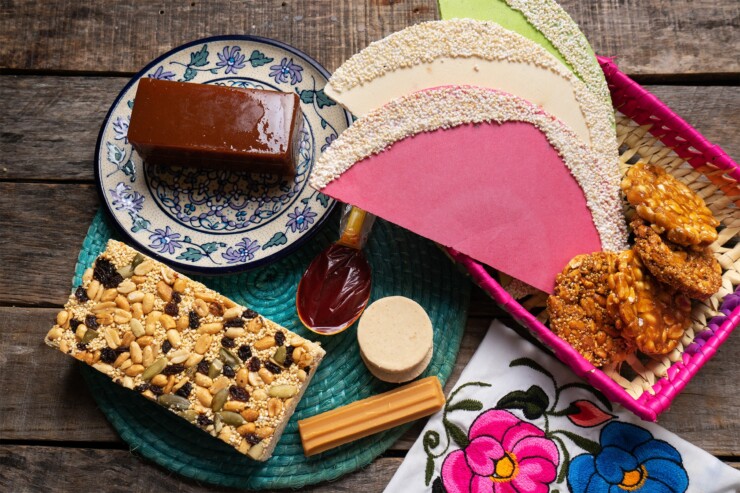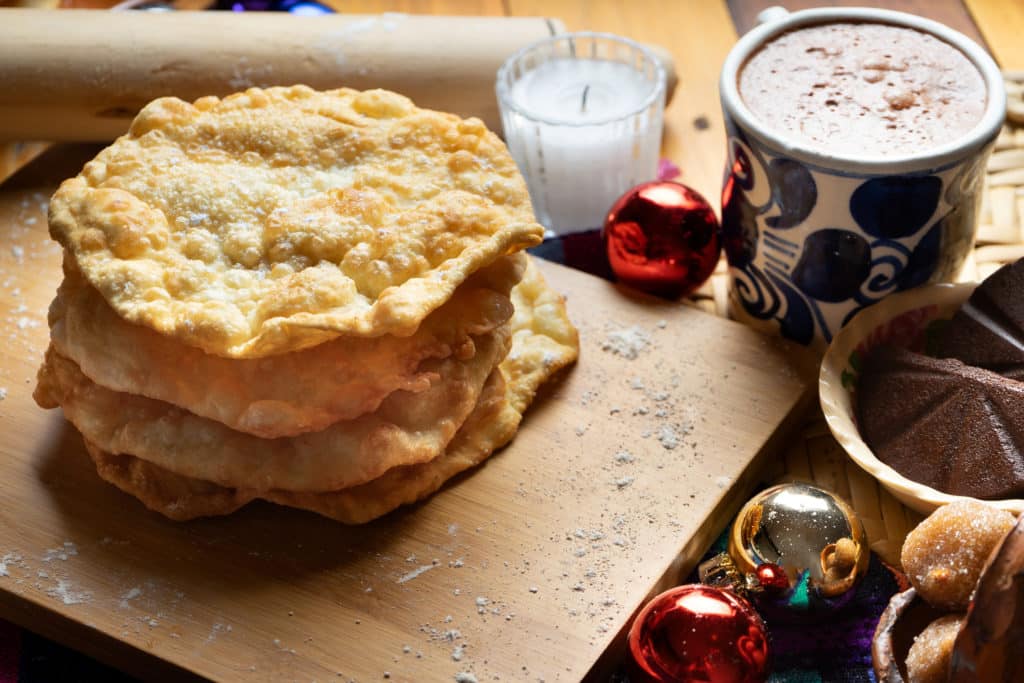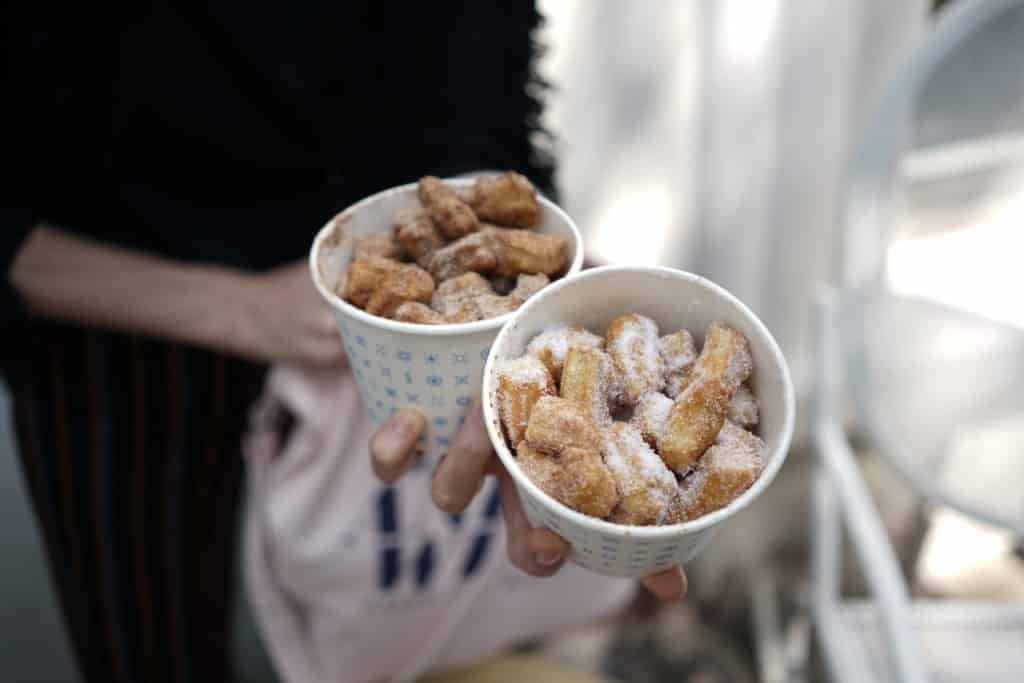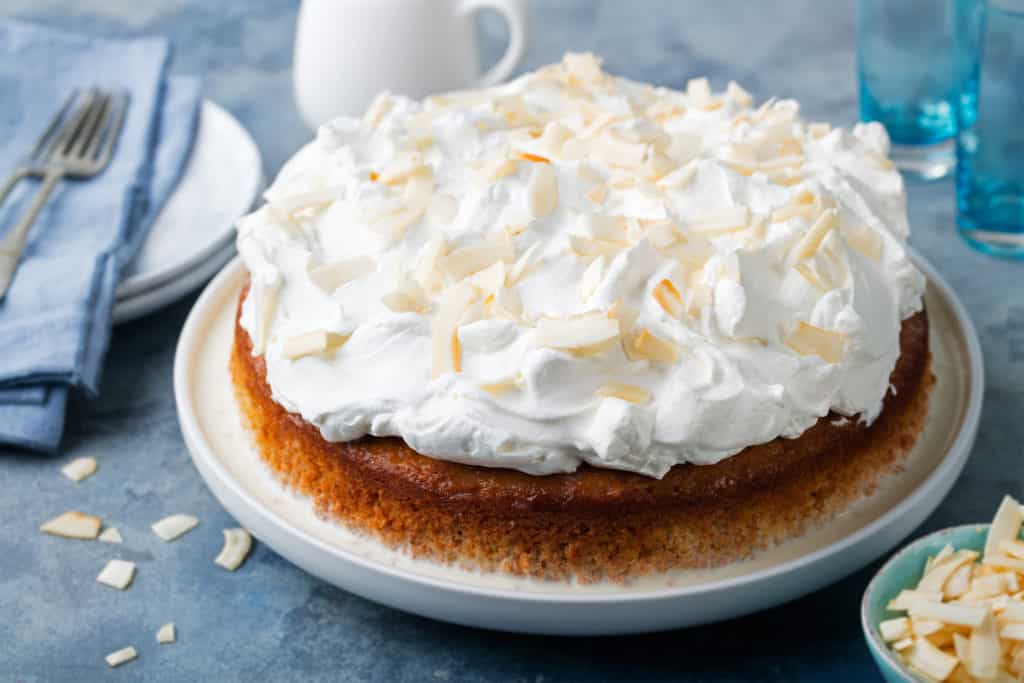No exaggeration: we could build you an eating itinerary where you focus on one Mexican region for every day of the year and you would eat something new to you each week.
From its variety of ingredients and cooking techniques to regional variations of the same dish (like tamales to pozole), there’s an entire universe within Mexican food. And it’s a major reason why we love eating our way through Mexico (and taking you with us, too). Though Mexico’s culinary diversity doesn’t stop at breakfast, lunch, or dinner. It extends to desserts too.

15 Traditional Regional Mexican Desserts
You are probably already familiar with beloved Mexican dessert recipes like Mexican wedding cookies, sopapillas, sweet breads like conchas, or Mexican hot chocolate. But it’s essential to know these 15 traditional Mexican desserts, including regional specialties like Sonora’s coyota and Mexico City’s garibaldi.
Alegría
Named alegría after the Spanish word meaning joy, these sweetened amaranth candies have a history dating back to Aztec times. In central Mexico, they were originally made with amaranth grain sweetened with maguey (agave) syrup. Since then candy bars have evolved to include cane sugar and honey. Alegrías are sold all over Morelos state and Mexico City in central Mexico, and part of Mexico state.
Arroz con Leche
A typical Arroz con Leche recipe is made with rice, milk, cinnamon sticks, and sugar (and sometimes raisins) and is served hot or cold. The dessert likely has Moorish origins, but you’ll find variations across Latin America, Spain, and Asia. Rice pudding was introduced to Mexico in the 1500s by the Spanish, as rice and dairy were not part of Indigenous diets prior.

Buñuelo
When Christmas rolls around, the sweet, wafer-thin buñuelos make their appearance. Most recipes begin with a wheat-based dough and come in regional variations—such as those made with honey, cinnamon, or anise seeds. Buñuelos come from Spain originally, and versions are also found in Turkey and the Philippines. They are fried and eaten as both a dessert and snack throughout Mexico and Colombia, Nicaragua, and Cuba.
Cocada
Sweet and chewy coconut-based cocadas call for piloncillo (unrefined cane sugar), milk, and eggs which act as a binder to shape shredded coconut into little balls. They have a murky history yet likely come from the state of Colima on Mexico’s Pacific coast. Cocadas are popular throughout Latin America including Panama, Bolivia, and Colombia. Recipe variations may add vanilla and cloves.
Capirotada
As a common tradition during Lent and Easter, capirotada is a spiced bread pudding topped with cheese. Recipes sometimes call for nuts and fruits such as peanuts, almonds, and raisins, though the earliest versions were savory.
Like many Mexican desserts, a number of cultures influenced capirotada’s recipe including the Romans (adding dairy) and Moors (adding spices like cinnamon and clove). Capirotada was also likely created during the 15th century as a way to save stale bread.
Cayota
Part cookie part empanada, crispy and flaky cayotas are a specialty of Mexico’s northwestern Sonora state. The literal Spanish to English translation of coyota means female coyote though it’s also used to refer to a female of Indigenous and Spanish descent or mestiza. In the U.S., you can find coyotas sold along the Arizona-Mexico border region. They’re traditionally stuffed with piloncillo (known as panocha in Sonora) but fillings also include pineapple, cajeta, and jamoncillo (more on that below).

Churro
Find churros—ridged batons of fried dough dusted with cinnamon sugar—all over Mexico from street vendors to bakeries and restaurants. At the renowned Churrería El Moro, they serve their churros along with dipping sauces like chocolate, cajeta, or dulce de leche. The Spanish introduced this treat to Mexico and its history before that likely has roots in China, Portugal, and the shepherds of the Spanish highlands.
Flan
Flan comes from the Latin word, “flado” meaning flat cake and it traveled to Mexico with the Spanish during the 1500s. Classic Mexican flan is a creamy custard with saucy caramel and is often stout and circular shaped. Traditionally Mexican home cooks made flan by simmering tightly covered molds under roiling water before ovens became more widely available. All over Mexico flan is now made in flavors like chocolate, and coconut as well as variations like Flan Napolitano, which calls for the addition of cream cheese and has an almost cheesecake-like texture.
Garibaldi
Mexico City panaderías (bakeries) everywhere sell garibaldis—small pound cakes glazed with apricot jam and coated with white sprinkles. They were reportedly invented by the Italian immigrant family in the 1880s who opened El Globo bakery, which has since grown into a mega-chain as part of Bimbo brands.
Jamoncillo
Originating from convents in Mexico City, jamoncillo is a fudgy candy made with caramelized milk and pepitas (pumpkin seeds.) Find jamoncillo mostly in central Mexico and in the state of Veracruz in particular. Its density means it can be shaped to look like animals and fruits, but they usually come in slices or blocks.
Mazapan
Mazapan candy is similar to marzipan you find in Europe, but in Mexico, peanuts replace the traditional almonds. Pistachios and pine nuts are alternatives. The nut paste and sugar candy come in various forms such as being shaped into little fruits (or like a puck in a well-known mazapan brand, De la Rosa) or cut into bars. Marzipan (and as such mazapan) has a number of origin stories. Some say the confection originated in China or the Middle East before it made its way to Europe. Spain, Portugal, and Germany all have their own nutty versions.
Paleta
Meaning “little stick,” in Spanish, paletas are popsicles often made from whole fruits, nuts, spices, and local flavorings like the sweet and tart-tasting tamarind, guava, and cajeta (goat milk-based caramel.) Little shops called paleterías specialize in selling these cool treats.
The earliest accounts of paletas’ origins hover around the 1930s when they were sold on the streets in Tocumbo, a small town in Mexico’s western state of Michoacán. Later, two Tocumbo locals would move to Mexico City to sell and franchise paleterías under the name La Michoacana. Currently, more than 15,000 locations exist across Mexico and the U.S.
Nieves de Garrafa
One traditional method of making ice cream in Mexico involves hand churning ingredients in metal containers, or garrafas, that sit in a wooden barrel full of ice and salt. What results is a texture more similar to gelato than ice cream. Nieve de garrafa refers to dairy-based flavors. On the other hand, nieve de agua is like sorbet with water-based flavors like límon (lime) and jamaica (hibiscus.)
Its earliest versions trace back to the tail end of the Aztec empire (the 1500s) when they transported ice from the tops of volcanoes and mixed it with fruits and honey.
Tamales Dulces
These classic steamed corn dough pockets wrapped in corn husks are known for their savory fillings though their sweeter counterparts are just as delicious. Tamale dulces are often stuffed in combos like sweet corn, pineapple, coconut, raisins, and cinnamon. Traditionally, tamales (whether savory or sweet) are accompanied by the corn-based drink, atole, and often make appearances during religious celebrations like Christmas and first communions.

Tres Leches Cake
As the name indicates, “three milks” cake uses three kinds of milk— evaporated milk, sweetened condensed milk, and whole milk or heavy cream. The various types of milk are used to make the sponge cake batter and to saturate the cake after baking. Sometimes it’s topped with whipped cream and the result is a subtly sweet and moist—not mushy—taste and texture. Tres Leches reportedly hails from Nicaragua and although it’s one of the most popular Mexican desserts, you’ll find it throughout Puerto Rico, Cuba, and Guatemala.
Have Us Plan Your Mexico Trip
Did you know we’re also a boutique travel agency that specializes in Mexico travel planning? If you’re looking to plan one of the best trips to Mexico, our Mexico trip planner services are here to help you plan your perfect itinerary.
Photo Credit: churro photo by SMarina; cocada photo and various mexican candies photo by Guajillo studio; tres leches cake by Anna_Pustynnikova